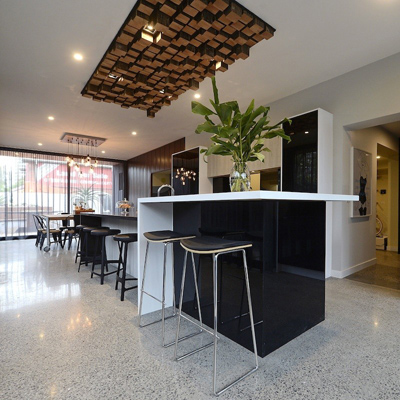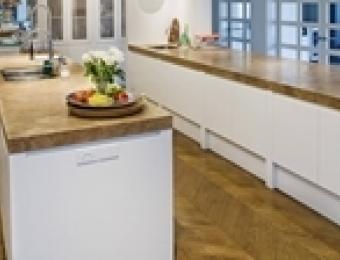
Polished concrete floors provide a smooth, high sheen finish that stands among the toughest wearing floors available. With the addition of dyes and pigments, huge variations on colour can be achieved and by cutting the surface and adding strips of wood or metal, patterns can be delineated. These floors are often found in large scale commercial facilities such as sports arenas and shopping malls.
Concrete floors can be polished in three ways; steel trowelling, burnishing and honing. Steel trowelled floors are hand trowelled to a semi-shine and can have the trowel marks left in or out. Burnishing usually requires machine trowelling and provides a higher gloss still, while honing involves grinding down the surface of the concrete to expose the aggregate. A finish is then applied to prevent moisture absorption and highlight the sheen even further.
Concrete floors have no bounce in them at all and can be unforgiving of falls. They don’t offer great sound or heat insulation but maintenance is a breeze and they are waterproof. Likewise, they can be used as thermal mass for the purpose of passive heating.
What should I look for when choosing a polished concrete floor?
The finish you choose for your polished concrete floor is an aesthetic one, but usually needs to be decided very early on because the machinery used in burnishing and honing needs to be used before the walls go up, or they won’t be able to reach the edges. The higher gloss floors can be prone to being slippery, which can cause some problems in high traffic areas.
Choice of aggregate in honed finishes will play a big part in how it looks, and also in the stability of the floor. For this reason, quartz and granite make good choices as they are hard wearing and attractive. Any patterns that will require materials to be inset into the concrete need to be set in while it is wet so it can harden without weakness.
Pigmentation and colour can be added in many different ways – directly into the concrete mix for integral colour, scattered in a mix with cement and sand over the drying surface in a method known as dry-shake, or applied through chemical stains using metallic salts which bond with the calcium in the cement to produce the desired colour. The colours produced by the last two methods are not consistent, but this can be used to create some unique effects, as no two floors will ever be alike.
How is polished concrete flooring installed?
A concrete floor can be laid in one of two ways – as part of the foundation slab or as a cap overlaid on an existing floor. For integral coloured concrete, pigmentation is added to the cement mix and is referred to as a percentage, usually in the range of 5-8%. Honed finishes require less pigmentation, as the aggregate will provide the main colour. Once prepared, the concrete is then poured and either hand or machine trowelled as required, until it achieves a high sheen finish. Any further colouring and design work is then completed and the concrete is coated with a finish, typically a wax-based sealant to prevent staining.
Suitability and maintenance
Concrete floors will be situational as they require a foundation slab, though should not be ruled out as an option if available as they can be highly decorative and can last in pristine condition for decades with care. They are water resistant making them useful in bathrooms and kitchens though they are prone to losing heat through proximity to the slab. Sound will also bounce off a concrete floor unless dampened with a rug.
Maintenance is easy, a mop will generally suffice. A re-waxing every 3-4 years is recommended for residential properties.
|
Advantages
|
Disadvantages
|





